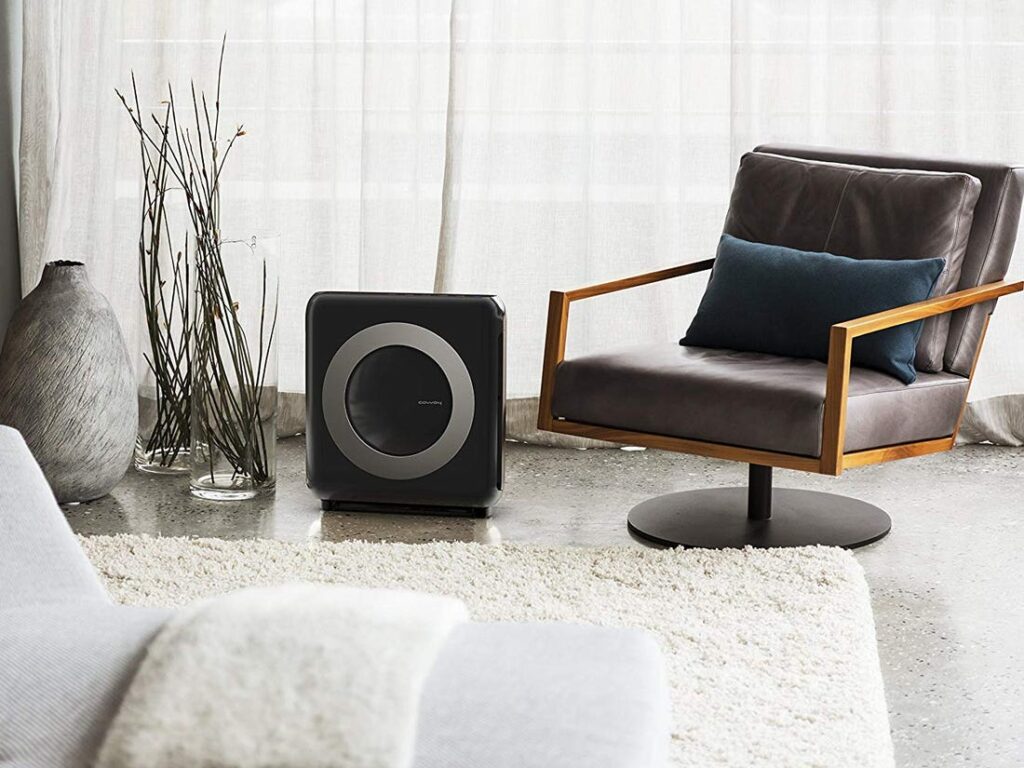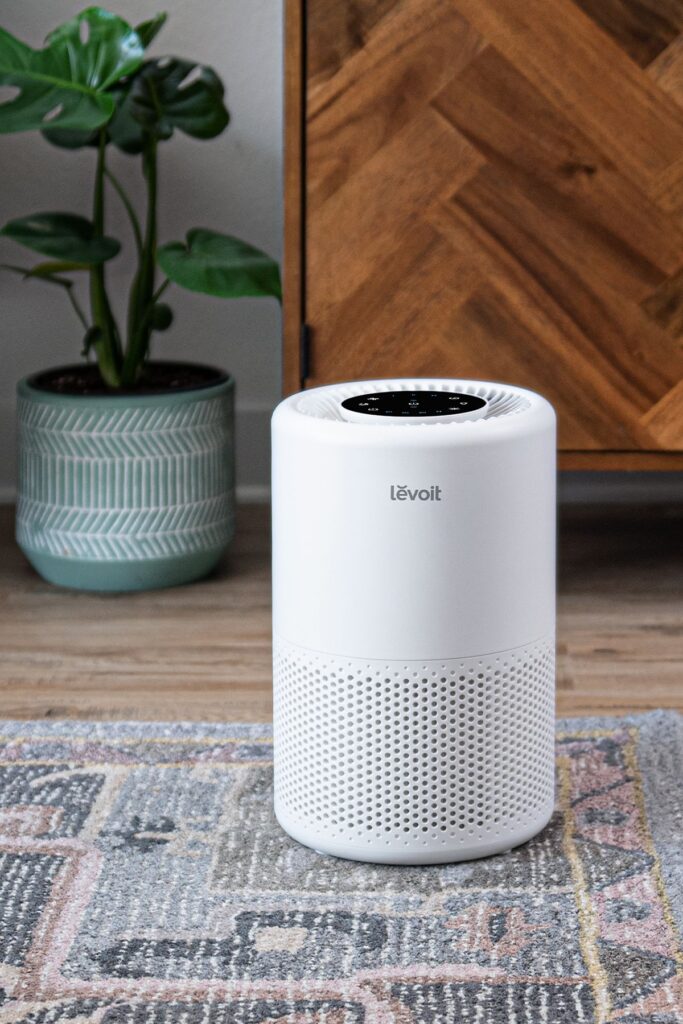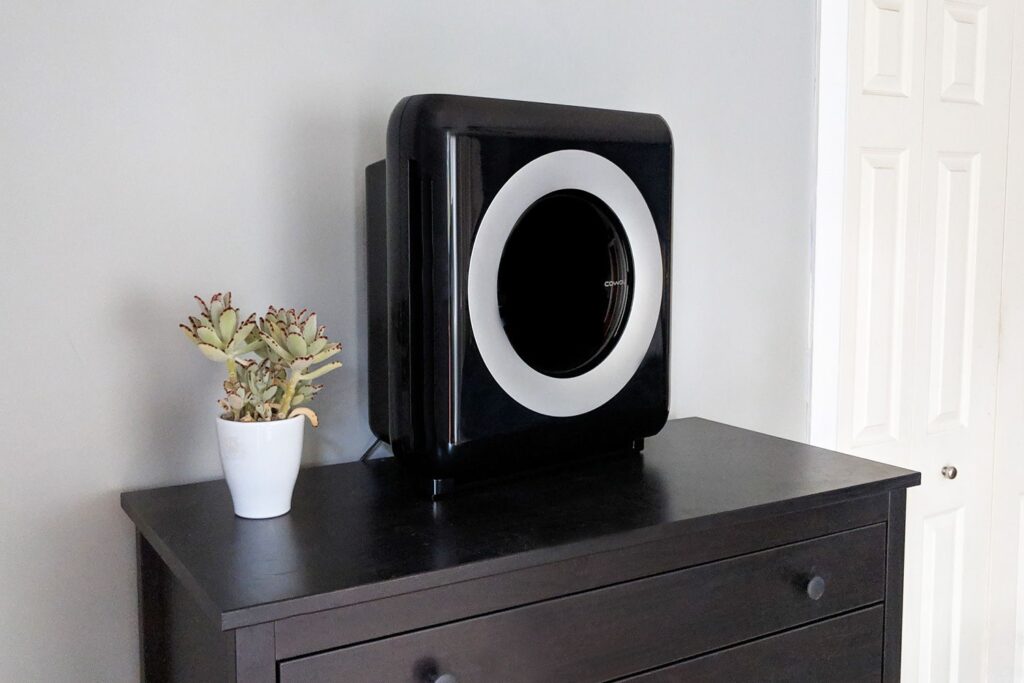We are all spending a lot of time in our home offices right now. Have you ever wondered how healthy the air is that you are breathing all day? And can this air quality be improved? Adding an air purifier to your home office can make a huge difference in reducing dust, mold spores, volatile organic compounds (VOCs), and even bad smells. I recently went through pretty obsessive research to find the best air purifier for working from home. I will go through what I consider the top 3 air purifiers for small spaces like offices and explain the pros and cons of each.
The best air purifier for working from home right now is the Coway 1512HH Mighty. This air purifier is a perfect size for a home office, offering a little more horsepower than necessary, allowing it to be run in a medium fan mode as opposed to high. Its four-stage filtration system features full HEPA certification and does a great job with dust and odors. It is a quiet unit for its level of performance and even comes with an air quality meter that can automatically trigger the unit to come on until the room reaches an adequate air quality level. If you have space, nothing beats the Coway 1512HH Mighty right now. If real estate in your office is at a premium, then you may want to consider the Levoit Core 200S which also comes with some excellent smart features.

Best Air Purifier: Coway 1512HH Mighty
This is the most well-rounded portable air purifier that you will find for a home office. The Coway 1512HH Mighty has a solid CADR rating, can turn on automatically when air pollutants are detected, and its filter replacements last a full 12 months before needing replacement.

Best smart air purifier: Levoit Core 200S
If you have a smaller office and want the bells and whistles that come with a wifi connection and smartphone app, then this is the unit for you. A respectable CADR rating for its size, scheduling, and voice assistant support, as well as very quiet operation, make the Levoit Core 200S a very good air purifier for work from home scenarios.
How our top picks stack up
We have narrowed down our top picks to three units that excel in different categories. We will go into all of the details of each unit in later sections, but this table provides some quick statistics about each of our top air purifiers.
| Coway 1512HH Mighty | Levoit Core 200S | Blueair 211+ | |
| Maximum room size | 361 ft2 | 183 ft2 | 540 ft2 |
| CADR rating | 208 ft3/min | 118 ft3/min | 350 ft3/min |
| Air changes per hour (ACH)* | |||
| – ACH for 150ft2 room | 10.4 | 5.9 | 17.5 |
| – ACH for 300ft2 room | 5.2 | 3 | 8.8 |
| – ACH for 500ft2 room | 3.1 | 1.8 | 5.3 |
| HEPA filter | Yes | Yes | No |
| HEPASilent filter | No | No | Yes |
| Activated carbon filter | Yes | Yes | Yes |
| Pre-filter | Yes | Yes | Yes |
| Smallest particles filtered | 0.3 microns | 0.3 microns | 0.1 microns |
| Ionizer | Yes | No | No |
| Noise level (low) | 24.4dB | 24dB | 31dB |
| Noise level (high) | 55.1dB | 48dB | 56dB |
| Schedules | No | Yes | No |
| Timer | Yes | Yes | No |
| Smart phone connection | No | Yes | No |
| Voice assistant compatible | No | Yes | No |
| Auto mode (with sensor) | Yes | No | No |
| Cost of replacement filter | $57.49 (link) | $19.99 (link) | $69.99 (link) |
| Estimated lifespan of filter | 12 months | 6-8 months | 6 months |
| Running cost per year | $57.49 | $39.98 | $139.98 |
Levoit VS Coway VS Blueair: What’s best?
We narrowed down our favorite air purifiers for home office use based on some basic criteria that you should be considering. Our ultimate favorite is the Coway 1512HH Mighty, and you’ll find out why.
Features
Filtration
Both the Coway 1512 and the Levoit 200S have true HEPA filters. This means they will provide the very best filtration available for consumers. The Blueair, on the other hand, uses a proprietary HEPASilent filter that claims to be even more efficient than HEPA. It is worth noting that HEPASilent is not a standardized designation and there are no other units on the market to compare to.
All three of these air purifiers use a pre-filter, HEPA filter, and activated carbon filter for deodorization. In the case of the Coway, these filters even come separate and install individually. Levoit opts for an integrated cylindrical filter that does the same job but is in one unit. The Blueair is a little different in the way the filter works. The pre-filter in its case is actually the fabric outer shell of the unit itself. In all cases, you would regularly clean off the pre-filter to avoid the build-up of large particles.
The Coway 1512HH is particularly good at removing smoke particles from the air, making it a very good option for those living in wildfire regions.
Filter costs per year
This is one area that people overlook when buying an air purifier. How much will this thing take to run yearly? This is the area where the Blueair really falters. They recommend buying a new filter every 6 months (vs 8 months on the Levoit and 12 months with the Coway). Not only this, but the filter is expensive! You would be shelling out well over one hundred dollars in filters every year. The Levoit comes in as the cheapest filter replacements per year at around $40.
Performance
This is a really important area. How well do these units do their job? In our experience in owning each of these, the Coway and the Blueair 211+ are about on par with each other in terms of air purifying performance. The Coway was easily able to quickly cycle through poor quality air in my 12ftx15ft home office. I know this because it has an air quality meter that can stop the unit when the air is clean. The Blueair also did an excellent job but is more of a dumb box so it just stays on even when the space is cleaned. The Blueair is a better unit for a large space, however. If your home office is in an open concept space like a living room or a basement, then it is a much better option since it has a higher CADR rating of 350 ft3/min. Levoit is no slouch either, but it is really meant for a smaller space. It is actually the unit I use permanently in my office due to its smart home smarts and decent cleaning efficiency.
Noise level
You certainly don’t want an air purifier running in your office that sounds like a jumbo jet taking off. This is one reason why we really like the Coway for office environments. Since it is a very powerful unit, you don’t need to run it in high mode. In most cases, low mode is just fine. And in this mode, it is very quiet. The Levoit, on the other hand, may need to run in medium mode, which is louder, since it is a less powerful unit. The Blueair 211+ is a louder unit generally so keep that in mind. If it is a larger space, then it won’t be an issue, but if you are planning on putting the unit close to your desk then consider the Coway 1512HH Mighty.
Smart features
This is where the three purifiers really differentiate themselves. The Levoit 200S is by far the smartest of the three, with its wifi connection and smartphone app connection. With it, you can set detailed schedules where the unit moves between power modes. For example, I have mine set through the Vsync app to come on to medium mode an hour before I arrive in my office in the morning and then it ramps to low mode at the time I would generally be sitting at my desk. This is a level of convenience that is super useful and it will allow you to turn on the unit automatically when it needs to be on as opposed to just leaving it on all the time. This should allow the filters to last quite a bit longer. The Levoit app also lets you know the life left in your filter based on usage and even allows you to order new filters! The Levoit 200S is also compatible with Amazon Alexa and Google Assistant so you can tell it to turn on or off (or to a specific speed) with your voice. I use this all the time in my office. Who wants to get up and push buttons? If you love the smart features but have a bigger room, consider the upgraded bigger brother, the Levoit PUR131S which also has app integration and wifi.
The Coway 1512HH is more of a conventional air purifier but it does have some smart tricks up its sleave. It can be programmed to use a basic timer (but not schedules). But the area that it beats the competition is its auto mode where it uses an on-board air quality meter. When the air is sufficiently clean, it will shut off. I have actually tested this a few times by shaking the canister of a vacuum cleaner to push some dust in the air and it is very accurate. It turns on right away.
The Blueair 211+ is truly a dumb air purifier. It has a single button that cycles between its three modes and that’s it. You turn it on manually and have to turn it off manually. This means the 211+ is more of a unit that should just be left on all the time. Unfortunately, its noise levels make this a bit of an annoyance in an office.
Other considerations
One feature that a lot of people are looking for is a night mode where the unit’s lights dim or turn off. This is is especially if you plan to also use the unit in a bedroom at night. Both the Levoit and the Coway 1512HH can completely turn off their lights while the Blueair has an obnoxiously bright light that is not suitable for most bedrooms.
The thing with air purifiers is they need to be placed within eyesight in a room to actually work correctly. This means you want something that looks good. Each of these units looks pretty good but the Blueair has an aesthetic that might fit in better in a living space. The Levoit is smaller than both of the others and features a fairly modern look that should fit into any office. The Coway is a like it or hate it aesthetic. It doesn’t look terrible, but it won’t win any beauty contests.
Conclusion: Best air purifier for working from home
The Coway 1512HH Mighty strikes an excellent balance between performance, features, and price. Unless you are looking to purify a particularly large room or want the smart features that the Levoit brings, go with the Coway 1512HH.

What to look for in a good office air purifier
Air purifiers are, at their core, very simple machines. They are basically fans that push air through a multi-stage filter to remove small particles from the air like dust or pollen. In fact, we have seen people online making makeshift air purifiers with large fans and MERV furnace air filters. But the air filters generally included on the best air purifiers are specially made to remove different types of air pollutants, not something you can achieve with a fan and a furnace filter.
Efficiency of air purifying
This is one of the main things you want to be looking for as you shop for a new air purifier. It is basically measuring how much air can be purified per unit time as well as what size room can reasonably be covered by a given size and power of air purifier.
The first way of measuring is this is called Clean Air Delivery Rate (CADR) and can be found on the advertising materials of pretty much any air purifier on the market. CADR is a standardized measurement that was introduced by the Association of Home Appliance Manufacturers and effectively measures how effectively an air purifier can deliver clean air, measured in cubic feet per minute. This CADR rating is a helpful way to compare different air purifier units against one another. Think of it kind of like horsepower in a car.
Another way to look at the efficiency of air purifiers is to calculate Air Changes Per Hour (ACH). This takes into account the actual cubic volume in your home office and will tell you how many complete exchanges of that room’s air it can achieve in an hour. This is related directly to CADR, but can give you a better idea of whether a given unit will work for your particular room or circumstance since it is looking at multiple air exchanges of a given time. Generally, we want to look for an air purifier that can do 5 complete air exchanges per hour in your given space.
How to decided calculate what size purifier I need for my room?
To figure out what size of air purifier you need, first grab your tape measure. Get measurements for the length and width of the room as well as the height of your ceiling in feet. Then you can take those numbers and figure out the minimum CADR rating you will need to sufficiently clean the air in that room. We recommend using the CADR Calculator here. So, for example, if I have a home office that measures 12ft x 12ft x 9ft (ceilings) and I want to have a full 5 air exchanges per hour (recommended) then I would need an air purifier of at least 108ft3/min or CFM. It is important to think of your room in three dimensions. Rooms with very high ceilings may need higher CADR-rated air purifiers than you think.
If you have found an air purifier that you like and would like to see if it will be suitable for your room, then your calculation will be opposite to the one above. Get the CADR rating from the air purifier in question, the measurements of your room, and plug them into this Air Changes Per Hour Calculator to get your ACH. For example, let’s say I like the feature set on the Levoit 200S. I would enter a CADR of 118 CFM, and the same room size of 12ft x 12ft x 9ft. This would tell me that this purifier is well-suited for this room because it outputs an ACH of 5.5 (air changes per hour).
How do air purifiers work?
There are two main ways that portable air purifiers actually remove pollutants from the air. The first is simply mechanical. In short, the purifier sucks air through an intake and then runs it through a series of physical filters that remove things like dust, dirt, pollen, bacteria, smoke, and volatile organic compounds from the air. The best filter you can buy to do this is a HEPA filter or high-efficiency particulate air filter. HEPA filters have been regulated by the EPA to be able to “…remove at least 99.97% of dust, pollen, mold, bacteria, and any airborne particles with a size of 0.3 microns (µm).” These have become the standard for air purifiers as well as in the medical industry. I would not recommend considering any air purifiers that do not use HEPA filters.
Some air purifiers will also employ electronic methods to actually add an electrical charge to particles as they enter the air purifier to essentially be able to “stick” particles more effectively in their filters. The Blueair 211+ uses this process. Other purifiers, like the Coway 1512HH Mighty, have ionizers that achieve a very similar goal of giving a negative electrical charge to particles, making them easier to catch by the purifier’s filter. Ionization can, theoretically, create ozone particles as they ionize, making this a feature that we would keep off in the Coway. HEAP filters and a good CADR rating are really all you need to consider in your purchase for the effectiveness of cleaning.
What can air purifiers filter out of the air?
Air filters equipped with HEPA filters can be very effective at removing particles all the way down to 0.3 microns. This includes:
| Effectiveness | Size of particle | |
| Pet dander | Excellent | 90 µm |
| Dust | Excellent | 1 – 100 µm |
| Pollen | Excellent | 10 – 200 µm |
| Mold spores | Excellent | 3 – 40 µm |
| Smoke | Very good | 0.4 – 0.7 µm |
| Bacteria | Very good | 0.3 – 60 µm |
| Viruses | Good | < 0.3 µm |
| COVID-19 virus | Good | 0.06 – 0.14 µm |
| Volatile organic compounds | Mixed | < 0.001 µm |
HEPA filters have been designed to effectively remove particles 0.3 microns and above. This includes pet dander, dust, pollen, mold spores, smoke (including wildfire smoke), and bacteria. However, recent evidence has shown that HEPA filters are actually quite a bit more effective than even that. A study by NASA in 2016 showed that HEPA filters are actually good at removing “ultra fine” particles from the air all the way down to 0.01 microns and possibly even smaller. This means that HEPA filters are actually effective at removing tiny airborne viruses from the air.
Can air purifiers filter out the COVID-19 virus?
Yes! In fact, the COVID-19 virus is present in the air through respiratory (saliva) droplets that have been aerosolized. These droplets are actually relatively large, at about 5 microns, a size that a HEPA filter can easily filter. The CDC even recommends that hospital rooms housing COVID-19 patients filter air through a HEPA filter.
Consider the addition of portable solutions (e.g., portable HEPA filtration units) to augment air quality in areas when permanent air-handling systems are not a feasible option.
Center for Disease Control, 2021
What about volatile organic compounds (VOCs)?
Volatile organic compounds are gaseous air pollutants that are often caused by the off-gassing of materials in your room. For example, paint or wood stain fumes would contain some VOCs. These are generally tiny particles, much smaller than what a HEPA filter can handle. However, because our top-rated models contain activated carbon filters, they can actually capture and neutralize many of these molecules. This is why activated carbon is recommended for removing smells in a room.
One major limitation of air purifiers
Of course, there is one limitation to air purifier filtration that must be mentioned. Many particles actually settle to your floor before they even have a chance to be captured by the air purifier’s filter. This means that regular vacuuming and floor/surface cleaning must be done in conjunction with a good air purifier to properly clean the air in a room.





1 Comment